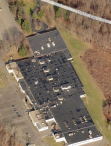Mill Record Middlebury
RETURN TO ‘FIND MILLS’Disclaimer: Content for these properties was compiled in 2014-2017 from a variety of sources and is subject to change. Updates are occasionally made under Property Information, however the Connecticut Trust for Historic Preservation (dba Preservation Connecticut) makes no representation or warranty that the information is complete or up-to-date.
- Complex Name (Common)
- Timex
- Complex Name (Historic)
-
- Timex
- Address or Location
- 199 Park Road Extension, Middlebury
- County
- New Haven
- Historic Designation
- Associated Mill Community
- n/a

- Historic Information
Companies Associated w/Complex
- Timex c.1960
- Waterbury Clock Company c.1942-c.1960
Use (Historic)
Largest Documented Workforce
Unknown
Historic Narrative
The Waterbury Clock Company was originally organized in 1857 as an offshoot of Benedict and Burnham Manufacturing Co. in Waterbury. In 1922, Waterbury Clock Co. purchased R. H. Ingersoll and Brothers, a firm which produced a range of products sold for a dollar, including toys, typewriters and, beginning with an 1892 contract with Waterbury Clock Co., pocket watches. During World War I, the partnership produced the newly invented wrist watch, and when Ingersoll went bankrupt, Waterbury Clock assumed their marketing as well as production. In 1929, the firm acquired the rights to a new Walt Disney cartoon character, Mickey Mouse, and introduced the Mickey Mouse watch at the 1933 Chicago World's Fair; it was an immediate success. Starting in 1941, the firm was managed by two Norwegians fleeing Nazi occupation, Thomas Olsen and Joakim Lehmkuhl. Under their leadership, especially that of Lehmkuhl, an MIT graduate, the company became one of the largest military producers in the country and the largest time fuse producer during World War II. The Middlebury plant was built in 1942 in direct response to the United States' involvement in World War II, with government funds to fulfill contract orders for the production of bomb timing fuses, gyroscopes and other military products. The 120,000 square foot building was constructed on what was called Ingersoll Hill, in honor of R. H. Ingersoll and Brothers, by 700 workers in only 88 days, in order to supply the US military as quickly as possible. With air conditioning, humidity and dust control, and simulated natural light, it was considered one of the world’s most modern manufacturing facilities at the time. In 1944, the company name was changed to United States Time Corporation, and it began producing 'Timex' watches for nurses. The watch was marketed for general commercial use around 1950, becoming quite popular. In 1969, United States Time Corporation became Timex, reflecting the importance of that inexpensive and reliable wristwatch. Timex is now owned by a Dutch holding company.
- Architectural Information
Number of Existing Buildings
Three (3) primary blocks.
Dates of Construction
1942, c.1960-1970
Architect
Leo F. Caproni (1942)
Builder
n/a
Building Type
Architectural Description
The building was built almost entirely of concrete, using Turner Mushroom Columns for support. It was located in a rural area, far from major transportation networks, to avoid easy detection by enemy aircraft. Furthermore, the roof was designed to be bomb-proof, and allegedly to hold water, so that the facility resembled a lake when flooded, instead of a sophisticated manufacturing facility. The building has nearly doubled in size since the 1940s, with substantial additions in the 1960s and 1970s.
Exterior Material(s)
Structural System(s)
Roof Form
Roof Material
n/a
Power Source
Condition
Fair
Condition Notes
n/a
- Property Information
-
Specific Location
One 30 acre parcel on the south side of Park Road west of route 63
Adjacent To
n/a
Exterior Visible from Public Road?
Yes
Parcel ID / Assessor Record Link
- 4-10/ / 140 / Link →
Acreage
30.0
Use (Present)
- Industrial
- Other: 2023, Timex property at 199 Park Rd Ext remodeled as professional and medical suites for lease. 8/2023, Timex Corporate HQ property at 555 Christian Rd (about 6 mi to the southwest), with 85k sq ft building designed by Fletcher Thompson and built in 2001, sold purportedly for warehouse use.
- Sources
-
Form Completed By
Michael Forino
Date
August 2014
Bibliography
- Gifford, Emily. 'Timex: Takes a Licking and Keeps on Ticking,' in Connecticut Explored, Winter 2015-2016 (West Hartford).
- Sanborn Insurance Atlases.
- Information, historic photographs and sources for Leo Caproni courtesy Gregg Bateman (2018).
- Caproni, Leo F., ‘Industrial Buildings’ (1942 booklet)
- McDermott, Kathleen. "Timex, A company and Its Community, 1854-1998" (Timex Corp., 1998).
- Representative View(s)Click on image to view full file














